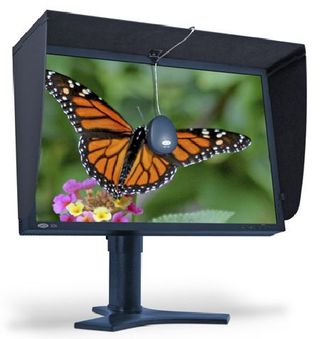Eizo CG241W And LaCie 526 Pro LCD Displays
By Barry Gerber
Professional and enthusiast digital photographers and designers need to see colors, contrast, and brightness on their displays as close as possible to how they will appear on the Web, or on different kinds of printer paper. The trick to achieving convergence between a display and an output device is color calibration. And the trick to quality color calibration is, I'm sad to say, money. You need a display that can be accurately and reliably calibrated for the specific use or uses you need, and that means spending big bucks. If you want to print your images, plan to spend more big bucks for a printer with an advanced ink set and other features, as well as excellently calibrated color profiles for different kinds of media.

Sarah and Eizo's CG241W set in portrait mode.
Two of the most popular LCD displays among pros and enthusiasts are Eizo's CG241W and LaCie's 526. Both support automatic color calibration after you set a few basic parameters, and based on my experience, both provide fantastic color, contrast and brightness matching for various output devices. Note that these devices are not designed for gaming or watching HD video. You can certainly do these things, but the results won't be as good as they would be on a display specifically designed for such functions, which you can get for far less cost anyway.
Proponents of these two companies and their displays often engage in lively discussion on Web forums and in blog face-offs. Why all the debate? Most of it is sparked by those who own one of the displays or by those who have seen one or the other in a local store. Those who have seen both together, fully calibrated, tend to find no significant differences between them.

LaCie's 526 display in all its glory.
Take a look at the manufacturers' specs for the CG241W and 526 and you'll find them close on most features. However, the Eizo, at around $2,345 without color calibration hardware, is $375 more than the LaCie without such hardware ($1,970). With lower-priced third party calibration hardware, the Eizo costs a minimum of $2,545, while the LaCie comes in a special package with calibration hardware for $2,200, a difference of $345. These are all street prices, incidentally.
| Characteristic | Eizo CG241W | LaCie 526 |
|---|---|---|
| Display Size | 24.1" | 25.5" |
| Native Resolution | 1920x1200 | 1920x1200 |
| Pixel Pitch | 0.27 | 0.287 |
| Aspect Ratio | 16:10 | 16:10 |
| Contrast Ratio | 850:1 | 800:1 |
| Brightness | 300 cd/m^2 | 400 cd/m^2 |
| Response Time (Gray to Gray) | 6 ms | 8 ms |
| Viewing Angles | 178 degrees Vertical and Horizontal | 178 degrees Vertical and Horizontal |
| Inputs | Dual DVI-I, VGA with Adapter | Dual DVI-I or D, VGA with Adapter |
| Percent of Adobe RGB Color Space Displayable | 96% | 95% |
| Auto Color Calibration | Yes | Yes |
| Color Calibration Hardware Included in Price | No, Uses 3rd Party Hardware | Optional in Higher Priced Package |
| Display May Be Used in Landscape or Portrait Mode | Yes | Yes |
| Includes Display Hood | Yes | Yes |
| PC and Mac Compatible | Yes | Yes |
| Power Consumption | 110 W | 111 W |
| Dimensions With Stand (WxHxD) | 22.3 × 21.2 (max) × 9.10 in. (566 × 538 (max) × 230 mm) | 23.2 x 23.4 (max) x 12 in. (589.8 x 594.2 (max) x 306 mm) |
| Weight With Stand | 24.3 lbs (11 kg ) | 28 lb (13.1 kg) |
| Warranty | 5 Year Limited (LCD and Backlight - 3 years) | 3 Year Limited |
Current page: Eizo CG241W And LaCie 526 Pro LCD Displays
Prev Page HP MediaSmart TV Next Page IOGEAR Hi Def Automatic HDMI Switch (GHDMIAS2) Adds Second PortStay on the Cutting Edge
Join the experts who read Tom's Hardware for the inside track on enthusiast PC tech news — and have for over 25 years. We'll send breaking news and in-depth reviews of CPUs, GPUs, AI, maker hardware and more straight to your inbox.
Ed Tittel is a long-time IT writer, researcher and consultant, and occasional contributor to Tom’s Hardware. A Windows Insider MVP since 2018, he likes to cover OS-related driver, troubleshooting, and security topics.
Most Popular


